Huế, the poetic and serene ancient capital, is not only renowned for its magnificent imperial architecture but also a convergence of profound cultural, historical, and spiritual values. In the heart of this peaceful city, Thiên Mụ Pagoda stands as a symbol, an indispensable “soul” of Huế. Visiting Thiên Mụ Pagoda, tourists not only admire its ancient, serene beauty but also find tranquility and peace in their souls. Join Discovery To Wonders on a spiritual journey to Thiên Mụ Pagoda to fully experience the beauty and spiritual significance of this special pagoda.
Thiên Mụ Pagoda – Spiritual Anchor and Cultural Icon of Huế
Formation History and Spiritual Tales
Thiên Mụ Pagoda, initially named Linh Mụ Tự, was built in 1601 during the reign of Lord Nguyễn Hoàng – the first Nguyễn lord who laid the foundation for the Nguyễn Dynasty later on. The pagoda is not only a religious architectural work but also associated with legendary stories imbued with spiritual colors, contributing to the mystery and sacredness of this place.
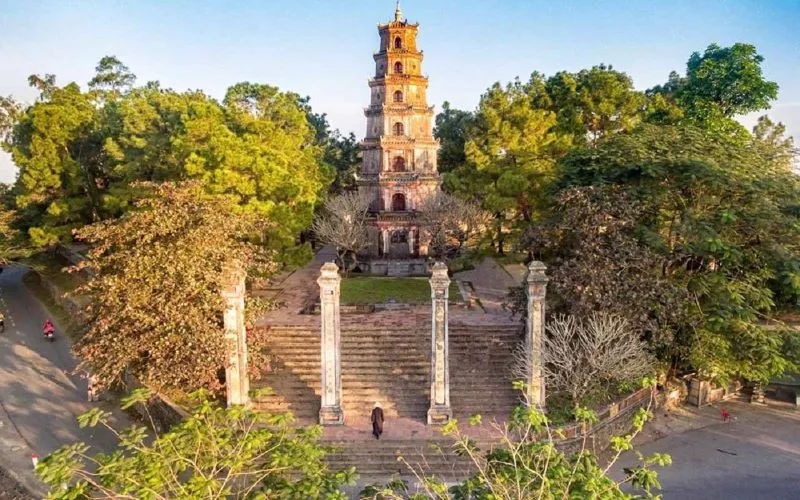
Discover the history and sacred origins of the name Thiên Mụ Pagoda (Photo: Collection)
Legend has it that when Lord Nguyễn Hoàng toured along the Hương River, upon reaching Hà Khê hill, he saw a hill shaped like a turtle facing the river. Asking local people, the Lord heard that an old woman in red clothes and green pants, calling herself Thiên Mụ, often appeared on the hill, announcing that a wise ruler would come to build a pagoda to gather spiritual energy and appease the dragon vein. Lord Nguyễn Hoàng was touched by this mystical story, believing it to be a sacred omen, so he decided to build the pagoda and named it Thiên Mụ Tự, hoping that the pagoda would bring peace and prosperity to the land of Thuận Hóa.
Another tale tells of a young monk who bravely criticized the harsh rule of Lord Nguyễn Phúc Chu. Before being executed, the monk prophesied that a Bodhisattva would come to build Thiên Mụ Pagoda on Hà Khê hill to ward off evil spirits and bring peace. Later, the image of “Thiên Mụ” – Heavenly Mother – appeared in legends, symbolizing the mysterious woman who realized the prophecy, building the sacred pagoda on Hà Khê hill. The name “Thiên Mụ” carries the meaning of reverence and admiration for the protecting goddess, while also expressing the spiritual role of the pagoda in suppressing evil, protecting, and spreading Buddhism.
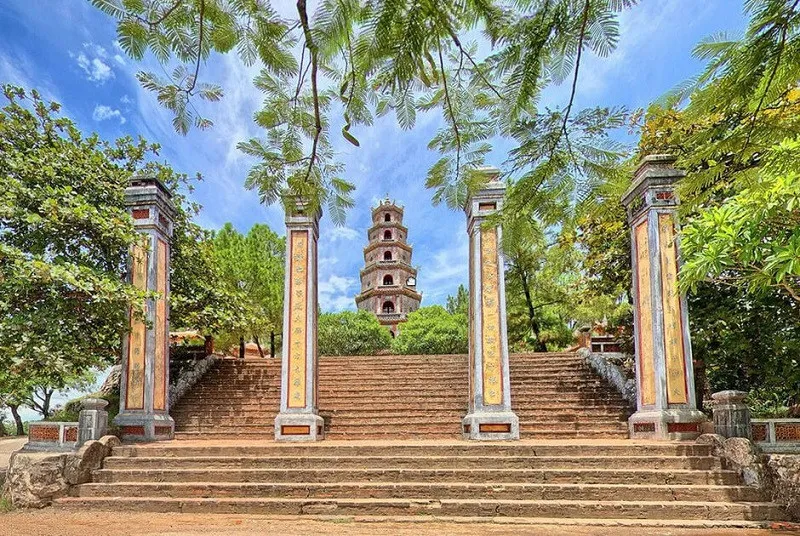
The ancient and sacred beauty of Thiên Mụ Pagoda, the “soul” of ancient Huế (Photo: Collection)
Regardless of which story is passed down, Thiên Mụ Pagoda remains a famous spiritual tourist destination in Huế, attracting many tourists and Buddhists to visit and pray for peace. The pagoda is not only a unique architectural work but also a place to send beliefs, hopes, and aspirations for a peaceful and happy life.
Prime Location, Picturesque Scenery
Thiên Mụ Pagoda is located at 1 Hương Giang Street, Hương Hòa Ward, Huế City, Thừa Thiên Huế Province. The pagoda is situated on Hà Khê hill, on the left bank of the poetic Hương River, about 5km west of the city center of Huế. This prime location not only gives Thiên Mụ Pagoda a quiet, peaceful space but also creates a beautiful natural setting, blending ancient architecture with picturesque river and mountain scenery.
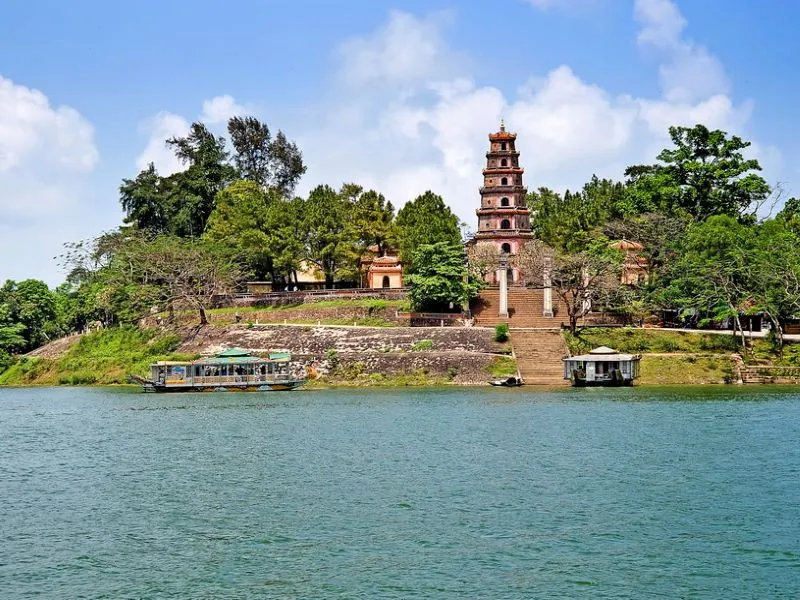
The poetic scenery of Thiên Mụ Pagoda by the Hương River (Photo: Collection)
Standing from Thiên Mụ Pagoda, visitors can take in the panoramic view of the winding Hương River, the majestic Ngự Bình Mountain, and the ancient city of Huế. This beautiful natural scenery has become an endless source of inspiration for many poets, musicians, and painters. Thiên Mụ Pagoda is not only a spiritual destination but also a famous scenic spot, contributing to the unique beauty of the dreamy land of Huế.
Journey to Explore the Spiritual Beauty at Thiên Mụ Pagoda
Majestic Tam Quan Gate
Stepping through the Tam Quan Gate, visitors seem to enter another world, separated from the noise and bustle of everyday life. The Tam Quan Gate of Thiên Mụ Pagoda is built in traditional architecture with three entrances symbolizing the Three Realms: the Realm of Humans, the Realm of Ghosts, and the Realm of Gods. The central gate, usually closed and only opened on major holidays, is elaborately decorated with intricate patterns, showing solemnity and grandeur.
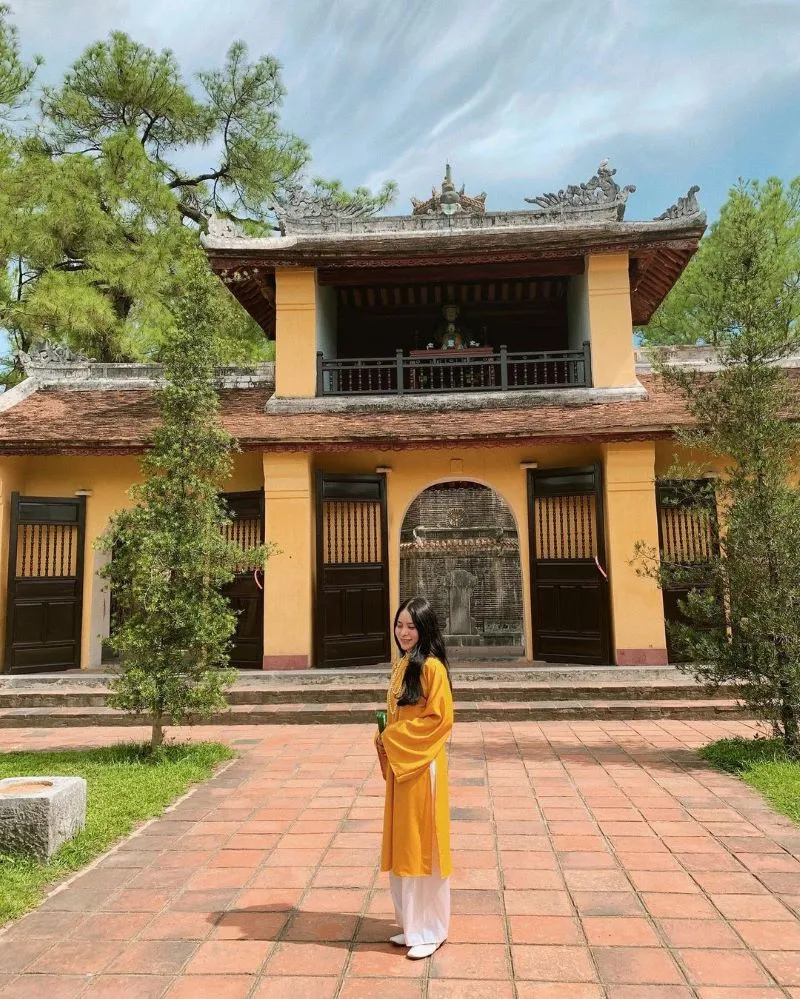
Majestic Tam Quan Gate, the entrance to the spiritual world of Thiên Mụ Pagoda (Photo: Collection)
The two side gates are wide open, welcoming visitors from all directions to worship and admire the pagoda. The Tam Quan Gate is not only an architectural work but also carries deep spiritual meaning, being the boundary between the mundane world and the sacred place, where the soul is cleansed and finds peace.
Phước Duyên Tower – Icon
Phước Duyên Tower, also known as Từ Nhân Tower, is one of the most famous symbols of Thiên Mụ Pagoda and the entire city of Huế. The tower was built in 1844, during the reign of King Thiệu Trị, with a height of 21 meters and 7 stories, each story worshiping a different Buddha. Phước Duyên Tower is not only a unique architectural work but also carries deep spiritual meaning, symbolizing the longevity of Buddhism and the wish for a peaceful and happy life.
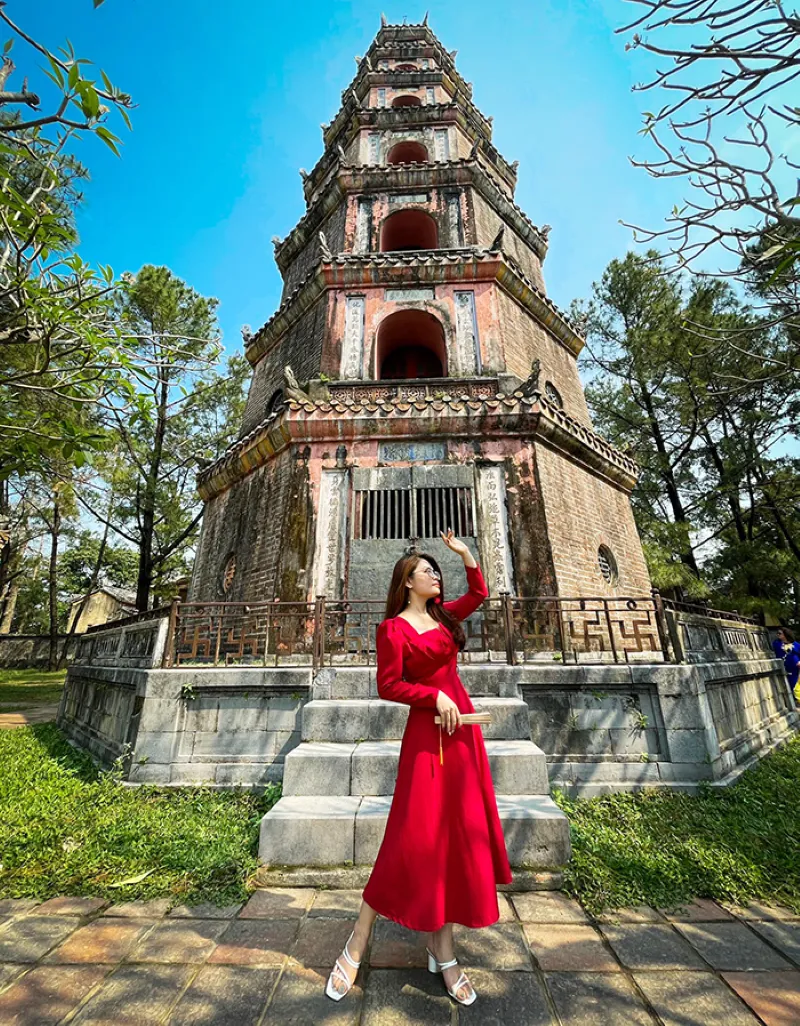
Phước Duyên Tower, an architectural and spiritual symbol of Thiên Mụ Pagoda (Photo: Collection)
Visitors can climb the tower floors to admire the panoramic view of Thiên Mụ Pagoda and the poetic Hương River. Each floor of the tower offers a different perspective, a different emotion, but all are directed towards tranquility and peace in the soul. Phước Duyên Tower is not only an attractive sightseeing spot but also a place for visitors to learn about the history, culture, and spirituality of Thiên Mụ Pagoda.
Điện Đại Hùng – Solemn Main Hall
Điện Đại Hùng is the main hall of Thiên Mụ Pagoda, where Buddha Di Lặc and Bodhisattvas are worshiped. The hall is built with traditional architecture, curved tile roofs, and sturdy lim wood columns, creating a solemn and ancient beauty. The space inside Điện Đại Hùng is harmoniously and delicately arranged, bringing a sense of peace and solemnity to visitors.
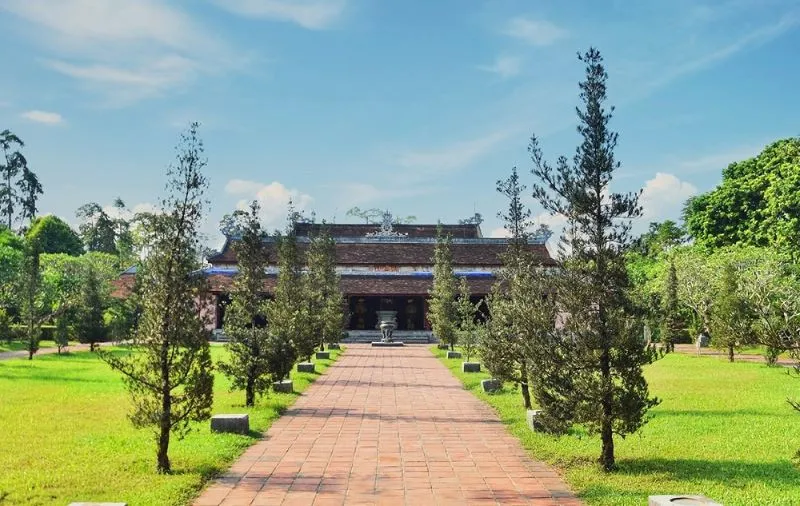
Điện Đại Hùng, a solemn and peaceful worship space (Photo: Collection)
Buddha Di Lặc is worshiped in the center of the hall, symbolizing joy, happiness, and optimism in life. Visitors to Điện Đại Hùng not only pray for peace and luck but also seek tranquility and peace in their souls, washing away the worries and anxieties of everyday life.
Tomb Tower Area of Venerable Thích Đôn Hậu – Serene
The tomb tower area of Venerable Thích Đôn Hậu is the resting place of the venerable monk who made great contributions to the restoration and development of Thiên Mụ Pagoda. Venerable Thích Đôn Hậu (1905-1992) was a learned and virtuous monk, who made many contributions to Vietnamese Buddhism and Thiên Mụ Pagoda. The tomb tower area is built solemnly and serenely, showing respect and remembrance for the venerable monk.
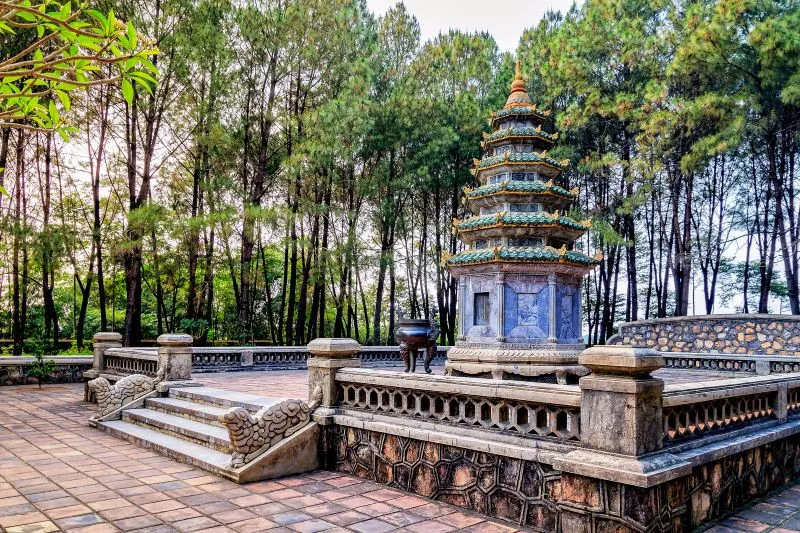
Tomb Tower Area of Venerable Thích Đôn Hậu, a place to remember the virtuous monk (Photo: Collection)
Visitors to the tomb tower area not only admire the unique architecture but also remember the merits of Venerable Thích Đôn Hậu, learn about his life and career, and feel the peace and serenity of this spiritual place.
Điện Địa Tạng – Tranquil Space
Điện Địa Tạng is located behind Điện Đại Hùng, a tranquil and peaceful space, bringing visitors a feeling of relaxation and lightness. The hall worships Địa Tạng Vương Bồ Tát, the Bodhisattva known for his vow to save sentient beings from hell. The space of Điện Địa Tạng is simply and elegantly decorated, with the echoing pagoda bell and the gentle breeze blowing through the trees, creating a peaceful and tranquil atmosphere.
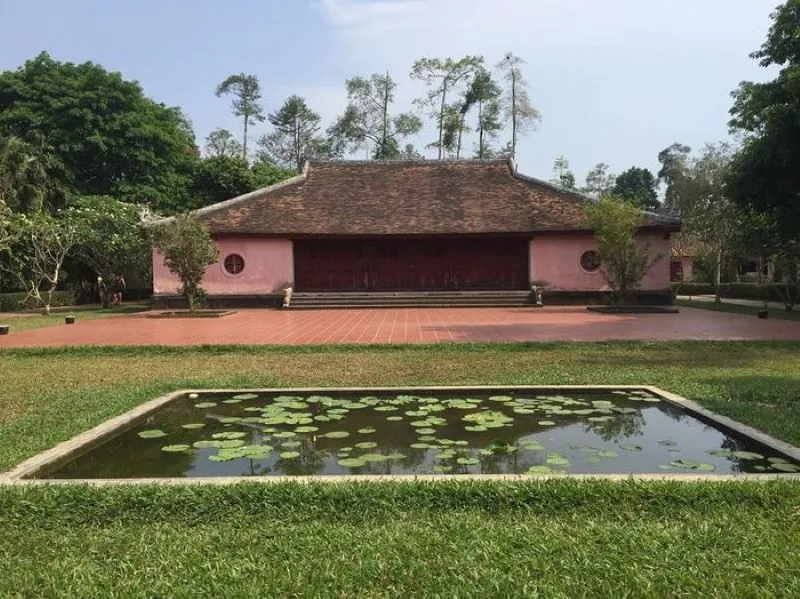
Điện Địa Tạng, a tranquil and peaceful space within the pagoda grounds (Photo: Collection)
Visitors come to Điện Địa Tạng to pray for peace, liberation from suffering, and seek tranquility and peace in their souls. The tranquil space of Điện Địa Tạng is an ideal place for visitors to listen to their hearts, reflect on life, and find their true selves.
Conclusion
Thiên Mụ Pagoda is not only an ancient and sacred pagoda but also a cultural and spiritual symbol of Huế. Spiritual tourism at Thiên Mụ Pagoda is a journey to explore the architectural, historical, cultural, and spiritual beauty of ancient Huế, as well as a journey to find tranquility and peace in the soul. Coming to Thiên Mụ Pagoda, visitors not only admire the beautiful scenery and learn about history but also experience the spiritual space, feel peace and tranquility, and find balance in life. If you are looking for a meaningful spiritual tourist destination in Huế, Thiên Mụ Pagoda is definitely a perfect choice. Come and feel the “soul” of ancient Huế, to make your spiritual journey more complete and meaningful.
If you want to explore more spiritual destinations in Huế and attractive Huế tours, do not hesitate to contact Đất Việt Tour via the free hotline 1800 6700 for the best advice and support.